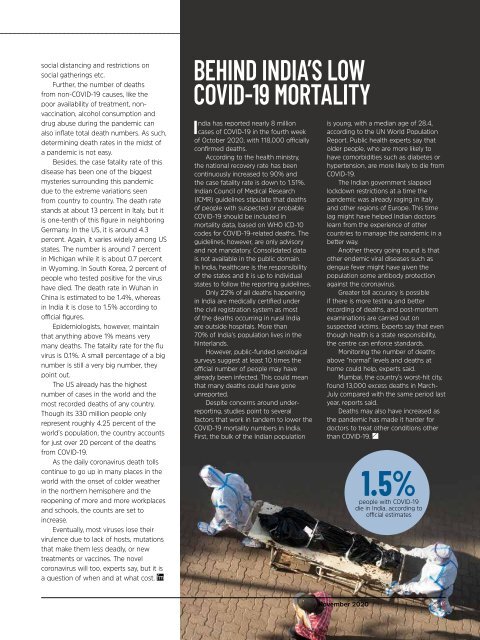FM November2020 Digital P
You also want an ePaper? Increase the reach of your titles
YUMPU automatically turns print PDFs into web optimized ePapers that Google loves.
social distancing and restrictions on<br />
social gatherings etc.<br />
Further, the number of deaths<br />
from non-COVID-19 causes, like the<br />
poor availability of treatment, nonvaccination,<br />
alcohol consumption and<br />
drug abuse during the pandemic can<br />
also inflate total death numbers. As such,<br />
determining death rates in the midst of<br />
a pandemic is not easy.<br />
Besides, the case fatality rate of this<br />
disease has been one of the biggest<br />
mysteries surrounding this pandemic<br />
due to the extreme variations seen<br />
from country to country. The death rate<br />
stands at about 13 percent in Italy, but it<br />
is one-tenth of this figure in neighboring<br />
Germany. In the US, it is around 4.3<br />
percent. Again, it varies widely among US<br />
states. The number is around 7 percent<br />
in Michigan while it is about 0.7 percent<br />
in Wyoming. In South Korea, 2 percent of<br />
people who tested positive for the virus<br />
have died. The death rate in Wuhan in<br />
China is estimated to be 1.4%, whereas<br />
in India it is close to 1.5% according to<br />
official figures.<br />
Epidemiologists, however, maintain<br />
that anything above 1% means very<br />
many deaths. The fatality rate for the flu<br />
virus is 0.1%. A small percentage of a big<br />
number is still a very big number, they<br />
point out.<br />
The US already has the highest<br />
number of cases in the world and the<br />
most recorded deaths of any country.<br />
Though its 330 million people only<br />
represent roughly 4.25 percent of the<br />
world’s population, the country accounts<br />
for just over 20 percent of the deaths<br />
from COVID-19.<br />
As the daily coronavirus death tolls<br />
continue to go up in many places in the<br />
world with the onset of colder weather<br />
in the northern hemisphere and the<br />
reopening of more and more workplaces<br />
and schools, the counts are set to<br />
increase.<br />
Eventually, most viruses lose their<br />
virulence due to lack of hosts, mutations<br />
that make them less deadly, or new<br />
treatments or vaccines. The novel<br />
coronavirus will too, experts say, but it is<br />
a question of when and at what cost.<br />
BEHIND INDIA’S LOW<br />
COVID-19 MORTALITY<br />
India has reported nearly 8 million<br />
cases of COVID-19 in the fourth week<br />
of October 2020, with 118,000 officially<br />
confirmed deaths.<br />
According to the health ministry,<br />
the national recovery rate has been<br />
continuously increased to 90% and<br />
the case fatality rate is down to 1.51%.<br />
Indian Council of Medical Research<br />
(ICMR) guidelines stipulate that deaths<br />
of people with suspected or probable<br />
COVID-19 should be included in<br />
mortality data, based on WHO ICD-10<br />
codes for COVID-19-related deaths. The<br />
guidelines, however, are only advisory<br />
and not mandatory. Consolidated data<br />
is not available in the public domain.<br />
In India, healthcare is the responsibility<br />
of the states and it is up to individual<br />
states to follow the reporting guidelines.<br />
Only 22% of all deaths happening<br />
in India are medically certified under<br />
the civil registration system as most<br />
of the deaths occurring in rural India<br />
are outside hospitals. More than<br />
70% of India’s population lives in the<br />
hinterlands.<br />
However, public-funded serological<br />
surveys suggest at least 10 times the<br />
official number of people may have<br />
already been infected. This could mean<br />
that many deaths could have gone<br />
unreported.<br />
Despite concerns around underreporting,<br />
studies point to several<br />
factors that work in tandem to lower the<br />
COVID-19 mortality numbers in India.<br />
First, the bulk of the Indian population<br />
is young, with a median age of 28.4,<br />
according to the UN World Population<br />
Report. Public health experts say that<br />
older people, who are more likely to<br />
have comorbidities such as diabetes or<br />
hypertension, are more likely to die from<br />
COVID-19.<br />
The Indian government slapped<br />
lockdown restrictions at a time the<br />
pandemic was already raging in Italy<br />
and other regions of Europe. This time<br />
lag might have helped Indian doctors<br />
learn from the experience of other<br />
countries to manage the pandemic in a<br />
better way.<br />
Another theory going round is that<br />
other endemic viral diseases such as<br />
dengue fever might have given the<br />
population some antibody protection<br />
against the coronavirus.<br />
Greater toll accuracy is possible<br />
if there is more testing and better<br />
recording of deaths, and post-mortem<br />
examinations are carried out on<br />
suspected victims. Experts say that even<br />
though health is a state responsibility,<br />
the centre can enforce standards.<br />
Monitoring the number of deaths<br />
above “normal” levels and deaths at<br />
home could help, experts said.<br />
Mumbai, the country’s worst-hit city,<br />
found 13,000 excess deaths in March-<br />
July compared with the same period last<br />
year, reports said.<br />
Deaths may also have increased as<br />
the pandemic has made it harder for<br />
doctors to treat other conditions other<br />
than COVID-19.<br />
1.5%<br />
people with COVID-19<br />
die in India, according to<br />
official estimates<br />
November 2020 / FUTURE MEDICINE / 59

















